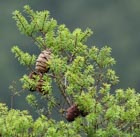Conservation Status

Pseudotsuga brevifolia
W.C. Cheng & Fu 1975
Common names
短叶黄杉 duanye huangshan [Chinese] (Wu and Raven 1999), Thiết sam giả [Vietnamese], Sá côống, Súa cúng [Hmong] (Loc et al. 2017).
Taxonomic notes
Syn: P. sinensis var. brevifolia (Cheng et Fu) Farjon et Silba 1990 (Wu and Raven 1999). See the discussion in Pseudotsuga regarding the rationale for treating this taxon at species rank. In particular, it is in a clade sister to P. sinensis and P. japonica.
Description
Trees to 35 m tall and 70 cm dbh, with a domed crown. Bark brown, scaly, longitudinally fissured. Twigs reddish brown, initially densely pubescent, turning light brown or gray and glabrous or subglabrous in 2nd or 3rd year. Leaves pectinately arranged, linear, 0.7-1.5(-2) cm × 2-3.2 mm, apex emarginate. Pollen cones axillary, solitary, pendulous, oblong-cylindric, 4-5 × 2.5-3.5 mm on a 3-4 mm peduncle. Seed cones axillary near ends of 2nd-year branches, ovoid-ellipsoid or ovoid, 3.7-6.5 × ca. 3.4 cm. Seed scales at middle of cones compressed orbicular-rhombic, 2.2-2.5 × ca. 3.3 cm, hard and woody, densely pubescent abaxially, base cuneate, not concave at sides. Bracts reflexed, cusp narrowly triangular, ca. 3 mm, lateral lobes triangular, margin erose. Seeds irregularly brown spotted, obliquely triangular-ovoid, ca. 2 cm including wing; wing reddish brown, lustrous, ca. 1 cm, pubescent on middle part adaxially (Wu and Raven 1999, Farjon (2010), Loc et al. 2017).
Distribution and Ecology
China: Guizhou and SW Guangxi, and Viet Nam: Cao Bang, Ha Giang and Bac Kan provinces (Farjon 2010, Loc et al. 2017). In China, typically scattered on S-facing slopes and mountain tops, on calcareous and rocky soils at approx. 1300 m elevation (Wu and Raven 1999). In Viet Nam, reported at 700-1300 m elevation on carbonate substrates, typically narrow ridgetops or cliffs, in pure stands or rarely with Keteleeria evelyniana (Loc et al. 2017).
Pseudotsuga of Asia; P. brevifolia in green. Distribution data from GBIF, 2021.02.22.
This species is assessed as "vulnerable" due to limited range, small area of occupancy, severe habitat fragmentation, and ongoing population declines driven mainly by livestock grazing, with secondary logging. There are a total of fewer than 10,000 mature trees and no population contains even 1,000 mature trees; it might qualify as "endangered" (Yang and Rushforth 2013).
Remarkable Specimens
Ethnobotany
Observations
Remarks
The epithet refers to the unusually short leaves.
Citations
Cheng, Wan-Chun, and Li-Kuo Fu. 1975. Gymnospermae Sinicae. Acta Phytotaxonomica Sinica 13(4):83. Available online at the Journal of Systematics and Evolution.
Loc, P. K., P. V. Te, P. K. Long, J. Regalado, and L. V. Averyanov. 2017. Native conifers of Vietnam – a review. Pakistan Journal of Botany 49:2037–2068 (as P. sinensis).
See also



